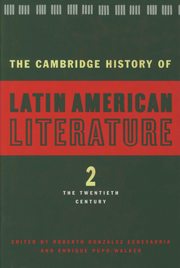Book contents
- Frontmatter
- Introduction to Volume 2
- 1 Modernist poetry
- 2 Modernist prose
- 3 The Vanguardia and its implications
- 4 The literature of Indigenismo
- 5 Afro-Hispanic American literature
- 6 The Criollista novel
- 7 The novel of the Mexican Revolution
- 8 The Spanish American novel from 1950 to 1975
- 9 The Spanish American novel: recent developments, 1975 to 1990
- 10 Spanish American poetry from 1922 to 1975
- 11 The modern essay in Spanish America
- 12 Literary criticism in Spanish America
- 13 The autobiographical narrative
- 14 The twentieth-century short story in Spanish America
- 15 Spanish American theatre in the twentieth century
- 16 Latin American (Hispanic Caribbean) literature written in the United States
- 17 Chicano literature
- Index
- Bibliographies
- References
9 - The Spanish American novel: recent developments, 1975 to 1990
Published online by Cambridge University Press: 28 March 2008
- Frontmatter
- Introduction to Volume 2
- 1 Modernist poetry
- 2 Modernist prose
- 3 The Vanguardia and its implications
- 4 The literature of Indigenismo
- 5 Afro-Hispanic American literature
- 6 The Criollista novel
- 7 The novel of the Mexican Revolution
- 8 The Spanish American novel from 1950 to 1975
- 9 The Spanish American novel: recent developments, 1975 to 1990
- 10 Spanish American poetry from 1922 to 1975
- 11 The modern essay in Spanish America
- 12 Literary criticism in Spanish America
- 13 The autobiographical narrative
- 14 The twentieth-century short story in Spanish America
- 15 Spanish American theatre in the twentieth century
- 16 Latin American (Hispanic Caribbean) literature written in the United States
- 17 Chicano literature
- Index
- Bibliographies
- References
Summary
The term “Boom” has been controversial since it was first coined to refer to the series of Spanish American novels that took the world by storm in the 1960s. At least in one sense, however, it is fortunate that the label has stuck, because it captures the confident, heady, atmosphere of the years when it seemed that Spanish America was finally going to take its place among the nations of the earth, not only culturally, but even politically and economically. The writers of the Boom have kept on writing, but it is undeniable that, by the mid-1970s, with the rise of right-wing dictatorships in Argentina and Chile and the economic recession brought on by the oil crisis, the Boom, in any sense of the word, had come to an end.
It is significant that after 1975 none of the major authors associated with the Boom publish “Boom novels.” Gabriel García Márquez’s El otoño del patriarca (1975) [The Autumn of the Patriarch], a work whose narrative experimentation brought him closer to the style of other Boom writers, is followed by Crónica de una muerte anunciada (1981) [Chronicle of a Death Foretold], a short work which returns to the clarity of Cien años de soledad (1967) [One Hundred Years of Solitude], and the Realism of even earlier works like La mala hora (1966) [In Evil Hour]. Mario Vargas Llosa’s Conversación en La Catedral (1969) [Conversation in The Cathedral], which develops the complex style of La casa verde (1966) [The Green House], is followed by the humorous and readable Pantaleón y las visitadoras (1973) Captain Pantoja and the Special Service].
- Type
- Chapter
- Information
- The Cambridge History of Latin American Literature , pp. 279 - 302Publisher: Cambridge University PressPrint publication year: 1996
References
- 3
- Cited by



